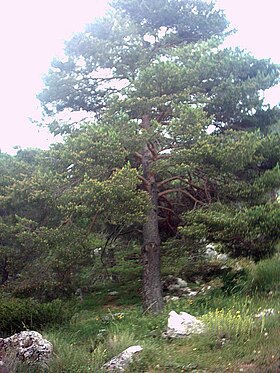
Granada is a province of southern Spain, in the eastern part of the autonomous community of Andalusia. It is bordered by the provinces of Albacete, Murcia, Almería, Jaén, Córdoba, Málaga, and the Mediterranean Sea. Its capital city is also called Granada.

Sierra Nevada is a mountain range in the region of Andalucia, in the province of Granada and, a little further, Málaga and Almería in Spain. It contains the highest point of continental Spain and the third highest in Europe, after the Caucasus Mountains and the Alps, Mulhacén at 3,479 metres (11,414 ft) above sea level.
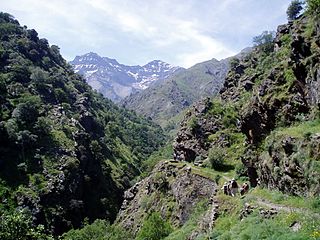
The Baetic System is one of the main systems of mountain ranges in Spain. Located in the southern and eastern Iberian Peninsula, it is also known as the Baetic Cordillera, Baetic Ranges or Baetic Mountains. The name of the mountain system derives from the ancient Roman region of Baetica, one of the Imperial Roman provinces of ancient Hispania.

Sierra de las Nieves is a mountain range of the Penibaetic System in Málaga Province, Andalusia, Spain. Its highest point is the 1,919 m high La Torrecilla peak. Enamorados is another notable peak.

The Sierra de Guadarrama is a mountain range forming the main eastern section of the Sistema Central, the system of mountain ranges along the centre of the Iberian Peninsula. It is located between the systems Sierra de Gredos in the province of Ávila, and Sierra de Ayllón in the province of Guadalajara.

Beas de Granada is a town located in the province of Granada, Andalusia, southern Spain. As of 2009, the town had a population of 1050 inhabitants. The settlement is at a height of 1072 meters above sea level and therefore has good views of the sierra Nevada. It is within the Parque Natural de la Sierra de Huetor.

Huétor Santillán is a municipality located in the province of Granada, southern Spain. Its territory is located at the feet of the Sierra de Huétor, between the Sierra Arana and the Sierra de la Alfaguara mountain ranges.

Nívar is a municipality located in the province of Granada, Spain, situated in the autonomous community of Andalusia. It is located in the centre-part of the county known as Vega de Granada, which its situated in the northeast skirt of Sierra de la Alfaguara. It is just 14 km away from the capital of the province. At the same time, it is confined by the municipalities of Cogollos Vega, Huétor Santillán, Alfacar and Güevéjar. According to the 2005 census (INE), the municipality has a population of 681 inhabitants.

The Tayrona National Natural Park is a protected area in the Colombian northern Caribbean region and within the jurisdiction of the city of Santa Marta, 34 kilometres (21 mi) from the city centre. The park presents a biodiversity endemic to the area of the Sierra Nevada de Santa Marta mountain range, featuring a variety of climates and geography that ranges from arid sea level to 900 meters above sea level. The park covers approximately 30 square kilometres (12 sq mi) of maritime area in the Caribbean sea and approximately 150 square kilometres (58 sq mi) of land.
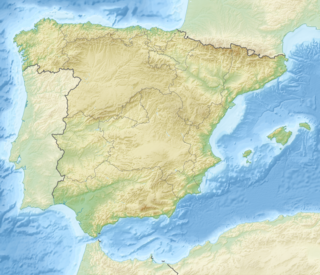
The Subbaetic or Sub-Baetic System is one of the three systems of mountain ranges of the Baetic System in the southern Iberian Peninsula. Highest point 2,027 m (6,650 ft) high Peña de la Cruz in Sierra Arana. Its northern limit includes the valley of the Guadalquivir in its western part.

The Sierra de las Quijadas National Park is a national park located in the northwestern part of the Argentine province of San Luis. It was established on December 10, 1991, to protect the natural features, representative of the Semiarid Chaco and the Argentine Low Monte ecoregions.
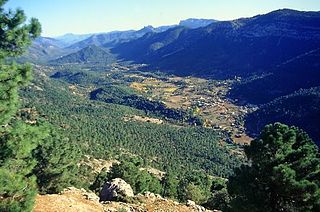
Sierras de Cazorla, Segura y Las Villas Natural Park is a natural park in the eastern and northeastern part of the province of Jaén, Spain, established in 1986. With an area of 2,099.2 square kilometres (810.5 sq mi), it is the largest protected area in Spain and the second largest in Europe. It was declared a biosphere reserve by UNESCO in 1983 and also a Special Protection Area for migratory birds in 1988.

The Sierra Arana or Sierra de Arana, also known as Sierra Harana, is a mountain range in the center of the province of Granada, southern Spain. Its highest peak is the Peña de la Cruz, at 2,027 m (6,650 ft).
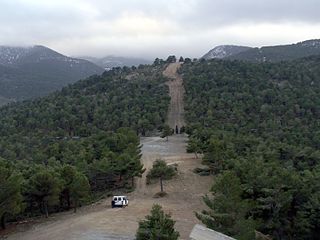
Sierra de Baza is a mountain range near the city of Baza in the Granada province in Spain. It is named after the town of Baza and its highest point is the 2,269 m high Calar de Santa Bárbara.

Chiribiquete National Natural Park is the largest national park in Colombia and the largest tropical rainforest national park in the world. It was established on 21 September 1989 and has been expanded twice, first in August 2013 and then in July 2018. The park occupies about 43,000 km2 (17,000 sq mi) and includes the Serranía de Chiribiquete mountains and the surrounding lowlands, which are covered by tropical moist forests, savannas and rivers.

The Sierra de Huétor and la Alfaguara Natural Park is a natural park in Andalusia, Spain. It is located near Granada city and was established in 1989.

The Sierra de Cogollos is a mountain range of the Baetic System in Granada Province, Andalusia, Spain.

Sierra de Alhama is a mountain range of the Penibaetic System in Málaga and Granada provinces, Andalusia, Spain. Its highest point is the 1,500 m high Pico de la Torca. Other notable summits are Hoyo del Toro, 1,353 m, Cerro de Marchamonas, 1,272 m and Morrón de la Cuna 1,222 m.

